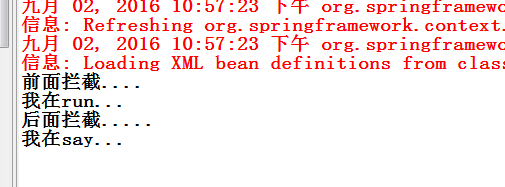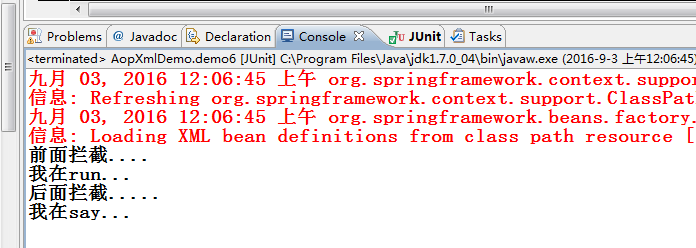您好,登錄后才能下訂單哦!
您好,登錄后才能下訂單哦!
小編給大家分享一下Spring AOP中如何實現自動代理,相信大部分人都還不怎么了解,因此分享這篇文章給大家參考一下,希望大家閱讀完這篇文章后大有收獲,下面讓我們一起去了解一下吧!
這里的自動代理,我講的是自動代理bean對象,其實就是在xml中讓我們不用配置代理工廠,也就是不用配置class為org.springframework.aop.framework.ProxyFactoryBean的bean。
總結了一下自己目前所學的知識。
發現有三種方式實現自動代理
用Spring一個自動代理類DefaultAdvisorAutoProxyCreator:
<bean class="org.springframework.aop.framework.autoproxy.DefaultAdvisorAutoProxyCreator" data-filtered="filtered"></bean>
例如:
原來不用自動代理的配置文件如下:
<!--?xml version="1.0" encoding="UTF-8"?--> <beans xmlns="https://www.springframework.org/schema/beans" xmlns:context="https://www.springframework.org/schema/context" xmlns:tx="https://www.springframework.org/schema/tx" xmlns:xsi="https://www.w3.org/2001/XMLSchema-instance" xsi:schemalocation="https://www.springframework.org/schema/beans https://www.springframework.org/schema/beans/spring-beans-4.3.xsd https://www.springframework.org/schema/context https://www.springframework.org/schema/context/spring-context-4.3.xsd https://www.springframework.org/schema/tx https://www.springframework.org/schema/tx/spring-tx-4.3.xsd"> <!-- 代理前原對象 --> <bean class="cn.hncu.xmlImpl.Person" id="person"></bean> <!-- 切面 = 切點+通知 --> <bean class="org.springframework.aop.support.RegexpMethodPointcutAdvisor" id="advisor"> <!-- 切點 --> <property name="patterns"> <list> <value>.*run.*</value> </list> </property> <!-- 通知-由我們寫,實際代理動作 --> <property name="advice"> <bean class="cn.hncu.xmlImpl.AroundAdvice" id="advice"></bean> </property> </bean> <!-- 代理工廠 --> <bean class="org.springframework.aop.framework.ProxyFactoryBean" id="personProxied"> <!-- 放入原型對象 --> <property name="target" ref="person"></property> <!-- 放入切面 --> <property name="interceptorNames"> <list> <value>advisor</value> </list> </property> </bean> </beans>
現在改用自動代理,如下配置:
<beans ...=""> <!-- 代理前原對象 --> <bean class="cn.hncu.xmlImpl.Person" id="person"></bean> <!-- 切面 = 切點+通知 --> <bean class="org.springframework.aop.support.RegexpMethodPointcutAdvisor" id="advisor"> <!-- 切點 --> <property name="patterns"> <list> <value>.*run.*</value> </list> </property> <!-- 通知-由我們寫,實際代理動作 --> <property name="advice"> <bean class="cn.hncu.xmlImpl.AroundAdvice" id="advice"></bean> </property> </bean> <!-- 自動代理 --> <bean class="org.springframework.aop.framework.autoproxy.DefaultAdvisorAutoProxyCreator"></bean> </beans>
測試方法
@Test//自動代理
public void demo4(){
ApplicationContext ctx = new ClassPathXmlApplicationContext("cn/hncu/xmlImpl/4.xml");
//我們直接在這里獲取Person對象就可以了,因為在最開始xml文件newPerson對象后,Spring就已經幫我們代理了!
Person p =ctx.getBean(Person.class);
p.run();
p.say();
}相對于前面,也就是把代理工廠部分換成自動代理了。
演示結果:

自己寫一個自動代理底層實現:
我們也可以寫一個類,來實現DefaultAdvisorAutoProxyCreator自動代理的功能!
首先,我們需要實現一個接口,也就是BeanPostProcessor接口。
BeanPostProcessor接口作用是:如果我們需要在Spring容器完成Bean的實例化、配置和其他的初始化前后添加一些自己的邏輯處理,我們就可以定義一個或者多個BeanPostProcessor接口的實現,然后注冊到容器中。
而我們想要在原型對象bean被創建之后就代理了,就必須在原來的容器中拿到原來的原型對象,需要拿到原來spring容器中的切面對象,這個時候,我們就需要原來的容器,這個時候就需要另一個接口,也就是ApplicationContextAware接口!
通過這2個接口,我們就可以實現自動代理了。
package cn.hncu.xmlImpl;
import org.springframework.aop.Advisor;
import org.springframework.aop.framework.ProxyFactoryBean;
import org.springframework.beans.BeansException;
import org.springframework.beans.factory.config.BeanPostProcessor;
import org.springframework.context.ApplicationContext;
import org.springframework.context.ApplicationContextAware;
public class MyAutoProxy implements BeanPostProcessor,ApplicationContextAware{
private ApplicationContext applicationContext=null;
//bean創建之前調用
@Override
public Object postProcessBeforeInitialization(Object bean, String beanName)
throws BeansException {
return bean;//在這里,我們直接放行
}
//bean創建之后調用
@Override
public Object postProcessAfterInitialization(Object bean, String beanName)
throws BeansException {
ProxyFactoryBean factory = new ProxyFactoryBean();
//把原型對象放入代理工廠
factory.setTarget(bean);
//在這里
Advisor adv = applicationContext.getBean(Advisor.class);
factory.addAdvisor(adv);
//返回被代理后的對象
return factory.getObject();
}
//拿到原來的spring中的容器
@Override
public void setApplicationContext(ApplicationContext applicationContext)
throws BeansException {
this.applicationContext=applicationContext;
}
}5.xml
<beans...> <!-- 代理前原對象 --> <bean class="cn.hncu.xmlImpl.Person" id="person"></bean> <!-- 切面 = 切點+通知 --> <bean class="org.springframework.aop.support.RegexpMethodPointcutAdvisor" id="advisor"> <!-- 切點 --> <property name="patterns"> <list> <value>.*run.*</value> </list> </property> <!-- 通知-由我們寫,實際代理動作 --> <property name="advice"> <bean class="cn.hncu.xmlImpl.AroundAdvice" id="advice"></bean> </property> </bean> <!-- 自己寫的自動代理 --> <bean class="cn.hncu.xmlImpl.MyAutoProxy"></bean> </beans...>
測試方法:
@Test//自己實現的自動代理
public void demo5(){
ApplicationContext ctx = new ClassPathXmlApplicationContext("cn/hncu/xmlImpl/5.xml");
Person p =ctx.getBean(Person.class);
p.run();
p.say();
}測試結果就不上圖了,和前面是一樣的。
其實很多時候,我們如果自己去練一下底層,對上層的框架更好理解。
還有一種方法。
使用aop標簽配自動代理
需要在beans加一個命名空間
xmlns:aop=https://www.springframework.org/schema/aop
還需要配xsi:schemaLocation,為aop加一個網絡地址。
https://www.springframework.org/schema/aop https://www.springframework.org/schema/aop/spring-aop-4.3.xsd
我們需要一個aspectjweaver-jar包:
xml配置文件:
<!--?xml version="1.0" encoding="UTF-8"?--> <beans xmlns="https://www.springframework.org/schema/beans" xmlns:aop="https://www.springframework.org/schema/aop" xmlns:context="https://www.springframework.org/schema/context" xmlns:tx="https://www.springframework.org/schema/tx" xmlns:xsi="https://www.w3.org/2001/XMLSchema-instance" xsi:schemalocation="https://www.springframework.org/schema/beans https://www.springframework.org/schema/beans/spring-beans-4.3.xsd https://www.springframework.org/schema/context https://www.springframework.org/schema/context/spring-context-4.3.xsd https://www.springframework.org/schema/tx https://www.springframework.org/schema/tx/spring-tx-4.3.xsd https://www.springframework.org/schema/aop https://www.springframework.org/schema/aop/spring-aop-4.3.xsd "> <!-- 利用sop標簽實現自動代理 --> </aop:aspectj-autoproxy> <!-- 代理前原對象 --> <bean class="cn.hncu.xmlImpl.Person" id="person"></bean> <!-- 切面 = 切點+通知 --> <bean class="org.springframework.aop.support.RegexpMethodPointcutAdvisor" id="advisor"> <!-- 切點 --> <property name="patterns"> <list> <value>.*run.*</value> </list> </property> <!-- 通知-由我們寫,實際代理動作 --> <property name="advice"> <bean class="cn.hncu.xmlImpl.AroundAdvice" id="advice"></bean> </property> </bean> </beans>
測試方法:
@Test//自動代理
public void demo6(){
ApplicationContext ctx = new ClassPathXmlApplicationContext("cn/hncu/xmlImpl/6.xml");
Person p =ctx.getBean(Person.class);
p.run();
p.say();
}測試結果:

以上是“Spring AOP中如何實現自動代理”這篇文章的所有內容,感謝各位的閱讀!相信大家都有了一定的了解,希望分享的內容對大家有所幫助,如果還想學習更多知識,歡迎關注億速云行業資訊頻道!
免責聲明:本站發布的內容(圖片、視頻和文字)以原創、轉載和分享為主,文章觀點不代表本網站立場,如果涉及侵權請聯系站長郵箱:is@yisu.com進行舉報,并提供相關證據,一經查實,將立刻刪除涉嫌侵權內容。